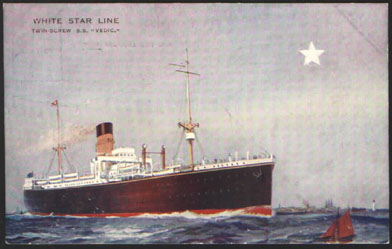SS Vedic
Appearance
This article needs additional citations for verification. (January 2017) |

| |
| History | |
|---|---|
| Name | SS Vedic |
| Owner | White Star Line |
| Operator | White Star Line |
| Port of registry | Liverpool |
| Route | Belfast-Clyde-Boston |
| Builder | Harland and Wolff |
| Yard number | 461 |
| Launched | 18 December 1917 |
| Completed | June 1918 |
| Maiden voyage | 11 July 1918 |
| In service | 10 July 1918 |
| Out of service | 1934 |
| Fate | Scrapped in 1934 |
| General characteristics | |
| Type | Cargo ship |
| Tonnage | 9,332 GRT |
| Length | 460.5 ft (140.4 m) |
| Beam | 58.3 ft (17.8 m) |
| Decks | 3 |
| Propulsion | Double propeller installation triple blades. |
| Speed | 14 knots (26 km/h; 16 mph) (design service speed) |
| Capacity | 1,250 third class |
SS Vedic was an ocean liner for the White Star Line, built in 1917 by Harland and Wolff. She was requisitioned as a troopship in World War One, for which she was extensively refitted.[1]
After the War, in 1920, Vedic saw passenger service as intended. She was once again refitted as an ocean liner, and immediately after traveled the Canada to Liverpool immigrant route. She took the Liverpool-Australia route in 1925.
In 1934, the White Star Line merged with its chief rival, Cunard Line, forming Cunard-White Star, Ltd. The newly formed company decided that the vessel was too old and needed to be retired from service. She was one of the first ships that Cunard-White Star sent to the breakers. She was sold for scrap in 1934.
References
- ^ McCluskie, Tom (2013). The Rise and Fall of Harland and Wolff. Stroud: The History Press. p. 129. ISBN 9780752488615.
